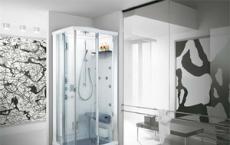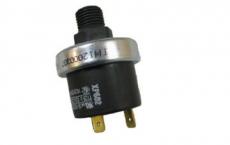Calculation of the power of an electric heating boiler. Electricity consumption. How to define it? Peculiarities of calculations for an electric boiler
The use of electricity as an energy source for heating a country house attractive for many reasons: easy access, prevalence, environmental friendliness. At the same time, the main obstacle to using electric boilers remains quite high tariffs. For this reason, the usefulness of the application depends first of all on how much electric power the electric boiler consumes.
There are two main methods for calculating the required capacity of an electric boiler. The first one is based on the heated area, the second one is based on heat losses through the enclosing structures.
The calculation for the first version is very rough, based on a single indicator - specific power. The specific power is given in the directories and depends on the region.
Image Gallery
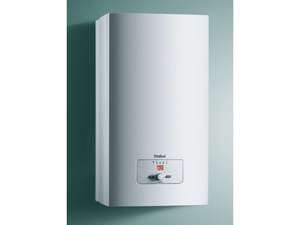



The calculation for the second option is more complicated, but takes into account a number of individual indices of a particular building. The full heat engineering calculation of the building is a rather complicated and painstaking task. Next, a simplified calculation, nevertheless possessing the necessary accuracy, will be considered.
Regardless of the calculation method, the quantity and quality of the collected raw data directly affect the correct assessment of the required power of the electric boiler.
If the power is too low, the equipment will always work with the maximum load, not providing the necessary comfort of living. When the power is too high - unjustifiably high power consumption, the high cost of heating equipment.
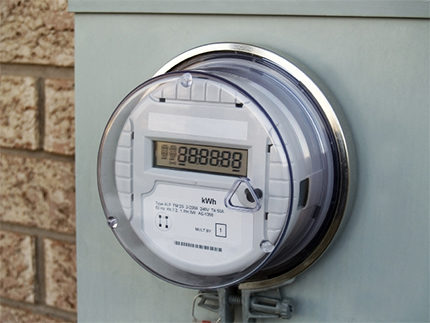
Unlike other fuels, electricity is an environmentally friendly, fairly clean and simple option, but tied to the availability of an uninterrupted power grid in the region
Collection of initial data for calculation
The following information about the building will be needed for the calculations:
S - the area of the heated room.
W ud Specific power. This indicator shows how much heat energy is needed per 1 m 2 per hour. Depends on local natural conditions, the following values can be accepted:
- for the central part of Russia: 120 - 150 W / m 2;
- for southern regions: 70-90 W / m 2;
- for northern regions: 150-200 W / m 2.
W ud - the theoretical value is applied mainly for very rough calculations, because it does not reflect the real heat loss of the building. Does not include the glazing area, the number of doors, the material of the external walls, the height of the ceilings.
Precise heat engineering calculation is carried out with the help of specialized programs taking into account many factors. For our purposes, such a calculation is not needed, it is quite possible to dispense with the heat loss of external enclosing structures.
The values to be used in calculations:
R - resistance to heat transfer or a coefficient of heat resistance. This is the ratio of the temperature difference along the edges of the enclosing structure to the heat flux passing through this structure. Has the dimension of m 2 × ⁰С / Вт.
In fact, everything is simple - R expresses the ability of the material to retain heat.
Q - a value indicating the amount of heat flow passing through 1 m 2 of the surface with a temperature difference of 1 ° C per hour. That is, it shows how much it loses the thermal energy of 1 m 2 of the enclosing structure per hour at a temperature drop of 1 degree. Has the dimension W / m 2 × h. For the calculations given here, there is no difference between Kelvin and degrees Celsius, since it is not the absolute temperature that is important, but only the difference.
Q total- the amount of heat flow passing through the area S of the enclosing structure per hour. Has the dimension of W / h.
P - capacity of the boiler. Calculated as the required maximum value of the capacity of the heating equipment at the maximum difference in the temperature of the outdoor and indoor air. In other words, sufficient capacity of the boiler for heating the building in the coldest season. Has the dimension of W / h.
Efficiency - the efficiency of the boiler, a dimensionless value indicating the ratio of the energy received to the energy expended. The documentation for the equipment is usually given as a percentage of 100 for example 99%. In calculations, a value of 1 is used. 0.99.
ΔT - shows the temperature difference on both sides of the enclosing structure. To make it clearer, how to calculate the difference look at the example. If outside: -30C, and inside + 22C⁰, then
ΔT = 22 - (-30) = 52 C Δ
Or too, but in the Kelvins:
ΔT = 293 - 243 = 52K
That is, the difference will always be the same for degrees and kelvins, so for reference calculations reference data in kelvins can be applied without amendments.
d - thickness of the enclosing structure in meters.
k - coefficient of thermal conductivity of the material of the enclosing structure, which is taken from directories or SNiP II-3-79 "Construction Heat Engineering" (SNiP - building codes). It has the dimension W / m × K or W / m × ⁰C.
The following list of formulas shows the relationship of the quantities:
- R = d / k
- R = ΔT / Q
- Q = ΔT / R
- Q total = Q × S
- P = Q total / EFFICIENCY
For multi-layer structures, the resistance to heat transfer R is calculated for each structure separately and then summed.
Sometimes the calculation of multi-layer structures can be too cumbersome, for example, when calculating the heat loss of a double-glazed window unit.
What needs to be taken into account when calculating the heat transfer resistance for windows:
- thickness of glass;
- the number of glasses and air gaps between them;
- type of gas between the panes: inert or air;
- presence of a heat-insulating covering of a window glass.
However, you can find ready-made values for the entire design, either from the manufacturer or in the reference book, at the end of this article you will find a table for insulating glass of a common design.
Calculation of heat losses in the ground floor
Separately, it is necessary to stop the calculation of heat loss through the floor of the building, since the ground has a significant resistance to heat transfer.
When calculating the heat loss of the basement floor, consideration should be given to penetration into the ground. If the house is at ground level, then the depth is assumed equal to 0. According to the conventional technique, the floor area is divided into 4 zones.
- 1 zone - retreats 2 m from the outer wall to the center of the floor along the perimeter. In the case of a deepening of the building, it retreats from the ground level to the level of the floor along a vertical wall. If the wall is buried in the ground at 2 m, then zone 1 will be completely on the wall.
- 2 zone - retreats 2m along the perimeter to the center from the border of zone 1.
- 3 zone - retreats 2 m along the perimeter to the center of the border of zone 2.
- 4 zone - the remaining floor.
For each zone from the established practice, there are R:
- R1 = 2.1 m 2 × ⁰С / Вт;
- R2 = 4.3 m 2 × ⁰С / Вт;
- R3 = 8.6 m 2 × ⁰С / Вт;
- R4 = 14.2 m 2 × ⁰С / Вт.
The values given for R are valid for uncoated floors. In case of insulation, each R is increased by R insulation.
In addition, for floors laid on logs, R is multiplied by a factor of 1.18.

Zone 1 has a width of 2 meters. If the house is buried, then you need to take the height of the walls in the ground, take away from 2 meters, and transfer the rest to the floor
Options for calculating the power of an electric boiler
Now you can start calculating. A formula that can serve to approximate the power of an electric boiler:
In the production of calculations, we take into account that Moscow belongs to the central region, i.e. W ud can be taken as equal to 130 W / m 2.
W ud = 130 × 150 = 19500 W / h or 19.5 kW / h
This figure is so inaccurate that it does not require an account of the efficiency of heating equipment.
Now we determine the heat loss through 15m 2 of the ceiling area insulated with mineral wool. The thickness of the layer of thermal insulation is 150 mm, the outside temperature is -30 ° C, inside the building + 22 ° C for 3 hours.
Solution: according to the table, we find the coefficient of thermal conductivity of mineral wool, k = 0.036 W / m × ⁰С. The thickness d must be taken in meters. The calculation procedure is as follows:
R = 0.15 / 0.036 = 4.167 m 2 × ° С / W
ΔT = 22 - (-30) = 52 ° C
Q = 52 / 4,167 = 12.48 W / m 2 × h
Q total = 12.48 × 15 = 187 W / h.
Calculated that the loss of heat through the ceiling will be in our example 187 * 3 = 561W.
Assumptions and simplifications in calculating
For our purposes, it is quite possible to simplify the calculations, calculating the heat loss of only external structures: walls and ceilings, not paying attention to internal partitions and doors.
In addition, you can do without calculating heat losses for ventilation and drainage. We will not take into account infiltration and wind load. Dependence of the location of the building on the sides of the world and the amount of solar radiation received.
From general considerations, one conclusion can be drawn. The larger the building volume, the less heat loss per 1 m 2. It is easy to explain this, since the area of the walls increases quadratically, and the volume in the cube. The ball has the least heat loss.
In enclosing structures only closed air layers are taken into account. If your house has a ventilated facade, then such an air layer is not considered closed, it is not taken into account. Do not take all the layers that follow in front of an unclosed air layer: facade tiles or cassettes.
Closed air layers, for example, in double-glazed windows are taken into account.
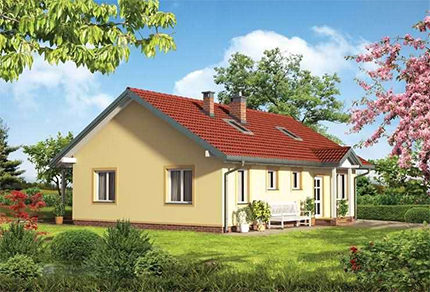
All the walls of the house are exterior. The attic is not heated, the heat resistance of roofing materials is not taken into account
Example of calculating the heat loss of a cottage
After the theoretical part, you can start practical. For example, calculate the house:
- the sizes of external walls: 9х10м;
- height: 3m;
- window with double-glazed windows 1.5 × 1,5m: 4 pcs;
- oak door 2.1 × 0,9m, thickness 50mm;
- pine floors 28mm, over an extruded foam 30mm thick, laid on logs;
- ceiling GKL 9mm, over mineral wool thickness 150mm;
- wall material: bricklaying 2 silicate bricks, insulation with mineral wool 50mm;
- the coldest period is 30 ° C, the design temperature inside the building is 20 ° C.
We make the preparatory calculations of the necessary areas. When calculating zones on the floor, we accept zero wall penetration. The floor board is lagged.
- windows - 9m 2;
- door - 1,9 m 2;
- walls, minus the windows and doors - 103.1 m 2;
- ceiling - 90m 2;
- floor areas: S1 = 60m2, S2 = 18m2, S3 = 10m2, S4 = 2m2;
- ΔT = 50⁰C.
Further on the directories or on the tables given at the end of this chapter, we select the necessary values of the coefficient of thermal conductivity for each material. For pine boards the coefficient must be taken along the fibers.
The whole calculation is quite simple:
Step # 1: Calculation of heat losses through load-bearing wall structures includes three actions.
- We calculate the heat loss coefficient of the brickwork walls.
R cyr = d / k = 0.51 / 0.7 = 0.73 m 2 × ° С / W.
- The same for a wall heater.
R ut = d / k = 0.05 / 0.043 = 1.16 m 2 × ° С / W.
- Heat losses of 1 m 2 of external walls.
Q = ΔT / (R kir + R ut) = 50 / (0.73 + 1.16) = 26.46 m 2 × ° С / W
As a result, the total heat losses of the walls will be:
Q st = Q × S = 26.46 × 103.1 = 2728 W / h.
Step # 2: Calculation of heat losses through windows:
Q window = 9 × 50 / 0,32 = 1406 W / h.
Step # 3: Counting of thermal energy leaks through the oak door.
Q dw = 1.9 × 50 / 0.23 = 413 W / h.
Step # 4: The loss of heat through the upper ceiling is the ceiling.
Q pot = 90 × 50 / (0.06 + 4.17) = 1064 W / h.
Step # 5: Count R ut for the floor as well in several actions.
- R ut = 0.16 + 0.83 = 0.99 m 2 × ° С / W.
- Then add R ut to each zone.
R1 = 3.09 m 2 × ° С / W; R2 = 5.29 m 2 × ° С / W;
R3 = 9.59 m 2 × ° С / W; R4 = 15.19 m 2 × ° С / W.
Step # 6: Since the floor is laid on the logs, multiply by a factor of 1.18.
R1 = 3.64 m 2 × ° С / W; R2 = 6.24 m 2 × ° С / W;
R3 = 11.32 m 2 × ° С / W; R4 = 17.92 m 2 × ° С / W.
Step # 7: We compute Q for each zone:
Q1 = 60 × 50 / 3.64 = 824 W / h;
Q2 = 18 × 50 / 6.24 = 144 W / h;
Q3 = 10 × 50 / 11.32 = 44 W / h;
Q4 = 2 × 50 / 17.92 = 6 W / h.
Step # 8: Now we can calculate Q for the whole sex.
Q floor = 824 + 144 + 44 + 6 = 1018 W / h.
Step # 9: As a result of our calculations, we can denote the sum of the total heat losses.
Q total = 2728 + 1406 + 413 + 1064 + 1018 = 6629W / h.
The calculation does not include heat loss associated with sewerage and ventilation. In order not to complicate excess measures, we simply add 5% to the listed leaks.
Of course, we need a stock, at least 10%.
Thus, the final figure of the heat loss of the house cited as an example will be:
Q total = 6629 × 1.15 = 7623 W / h.
Q total shows the maximum heat loss at home with a difference in outdoor and indoor air temperatures of 50 ° C.
W ud = 130 × 90 = 11700 W / h.
It is clear that the second version of the calculation is much more complicated, but it gives a more real figure for buildings with insulation. The first option allows to obtain a generalized value of heat loss for buildings with a low degree of thermal insulation, or even without it.
In the first case, the boiler will have to completely renew the heat losses every hour, taking place through openings, ceilings, walls without insulation. In the second case, it is necessary to heat only once before reaching a comfortable temperature. Then the boiler will need only to recover heat loss, the value of which is significantly lower than the first option.
Table 1:

The table shows the thermal conductivity for common building materials (+)
Table 2:
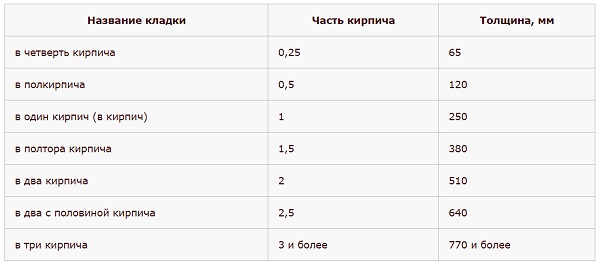
When calculating the thickness of the masonry, the thickness of the 10 mm joint is taken into account. Due to the cement joints, the thermal conductivity of the masonry is somewhat higher than that of the individual brick (+)
Table 3:
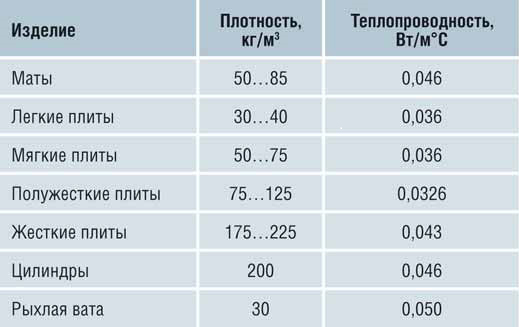
The table shows the values of the coefficient of thermal conductivity for various mineral wool boards. For insulation of facades a rigid plate is used
Table 4:

The designations in the table: Ar - filling of insulating glass with inert gas, K - the outer glass has a heat-protective coating, the thickness of the glass is 4mm. The remaining numbers indicate the gap between the glasses (+)
7.6 kW / h - this is the estimated required maximum power, which is spent on heating a well-insulated building. However, electric boilers also need some charge for their own power.
Calculation of electricity costs
If we simplify the technical nature of the heating boiler, then it can be called a conventional converter of electrical energy into its thermal analogue. Performing work on transformation, he also consumes some amount of energy. Those. The boiler receives a full unit of electricity, and only 0.98 parts are supplied for heating.
To obtain an accurate figure of electricity consumption by the electric heating boiler under study, its power (nominal in the first case and calculated in the second one) should be divided by the efficiency value declared by the manufacturer. On average, the efficiency of such equipment is 98%. As a result, the amount of energy consumption will be, for example, for the calculation version:
7.6 / 0.98 = 7.8 kW / h.
It remains to multiply the value by the local tariff. Then calculate the total cost of electric heating and look for ways to reduce them. For example, buy a two-rate counter, which allows you to partially pay for lower "night" tariffs. It is possible to include a thermo-accumulator in the heating circuit in order to store cheap energy at night, and spend it in the daytime.
Number of days requiring heating
Now that you have mastered the methodology for calculating future heat losses, you can easily estimate the cost of heating throughout the entire heating season.
According to SNiP 23-01-99 "Construction climatology" in columns 13 and 14 we find for Moscow the duration of the period with an average temperature below 10 ° C. For Moscow, this period lasts 231 days and has an average temperature of -2.2 ° C. To calculate Q total for ΔT = 22,2 ° C, it is not necessary to perform the entire calculation anew. It is enough to output Q total by 1 ° C:
Q total = 7623/50 = 152.46 W / h
Accordingly, for ΔT = 22,2 ° C:
Q total = 152.46 × 22.2 = 3385W / h
To find the consumed electricity, multiply by the heating period:
Q = 3385 × 231 × 24 × 1.05 = 18766440 W = 18766 kW
The above calculation is also interesting in that it allows us to analyze the entire structure of the house in terms of the effectiveness of the application of insulation.
Video about the calculation and selection of electric boilers
How to avoid heat loss through the foundation:
The use of electric boilers as the main heating equipment is very much limited by the possibilities of electric grids and the cost of electricity. However, as an additional, for example a solid fuel boiler, can be very effective and useful. Able to significantly reduce the time for heating the heating system or used as the main boiler at not very low temperatures.
There are situations when the only constant source of heat energy is electricity. In this case, for heating of living quarters, it is necessary to use electric boilers, which, in themselves, are good and functional, but they work on a rather expensive energy source.
That's why some citizens who are in a similar situation, and are interested in how to more accurately make the calculation of the boiler's power, which works using electricity. After all, you do not want to overpay for both energy consumption and the electric boiler for heating when you buy it.
In order to satisfy this interest, we will understand below how to calculate the power of an electric boiler, and as a result of which it is possible to reduce the consumption of energy consumed by heating the housing.
Professional calculation of the boiler in terms of capacity
When the calculation is necessary for efficient heating At home the power of the electric boiler is carried out by professional heat engineers, they take into account a large number of factors. In fact, the boiler's heat output must correspond, or better still slightly exceed, the total heat loss of the building, which take place at times of peak temperatures.
The basis of calculation in determining the heat loss of a house is its internal volume, and more precisely, the cubature of each separate room in it. However, and this is understandable, in different rooms with the same volume there will be different indicators of total heat losses, which depend on:
- the region in which the house is located, or rather the average seasonal temperatures and their peak declines characteristic of the area;
- thermal conductivity of external walls, ceiling ceilings, degree of thermal insulation of the floor;
- the area of windows, their condition and energy-saving capabilities;
- the area of the doorways that go out;
- the efficiency of the heating system (the method of routing the pipes, the scheme of connecting the batteries, their type, quantity, heat transfer)
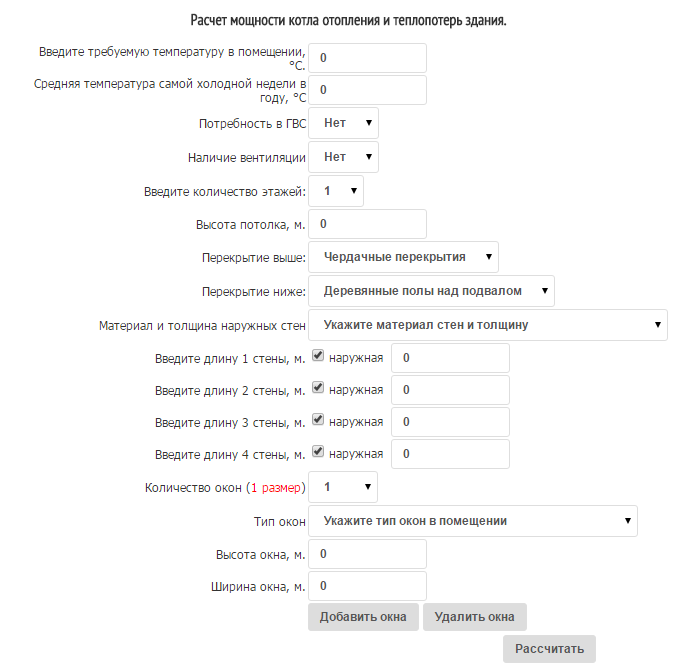
It is clear that being an amateur, taking into account all these data is very difficult, especially to determine, say, the thermal conductivity of the wall or the energy efficiency of the window, you need to use special measuring equipment. Therefore, often for calculation of the electric boiler required for full heating, the simplified formulas are used, and the results of the calculations are corrected with the help of correction factors.
Simplified methods of calculating electric boilers
Simpler methods for calculating the total amount of heat needed to heat a building assume the use of data in the calculations such as the area of the premises or their volume. It is clear that the accuracy of calculations in this case does not go, but at least there is the possibility of an approximate evaluation of what productivity it is worth purchasing an electric boiler.
If the heat loss by area is calculated, the value found (multiply the length by the width of the room) in meters should be increased by a factor of 100. So we will find the building's need for thermal energy, expressed in watts. To convert to kilowatts, the available number should be divided by 1000.
By volume, the power of the electric boiler is calculated as follows: first it is necessary to find the cubature (length x width x height) in meters and multiply the result by 40. This, again, watts, which need to be converted into kilowatts in the same way.
The first method is more accurate with a ceiling height of 2.40-2.60 m. If other dimensions are used, it is better to use the second method.
It is clear that the electric boiler will heat the entire house. Therefore, the data found for each room must be summed.
In order for the results found in the calculation results to be more reliable, some refinement coefficients can be used. The fact is that the above simplified calculations are valid if there is one window in the room (of standard sizes, that is, about 1.5 m2), and also one outer wall. In the case where the room is angular, the result obtained should be multiplied by 1.1. Another window gives the same correction. However, there are not only increasing coefficients, but also decreasing coefficients. If the outer wall is effectively insulated, a coefficient of 0.9 is applied. In the case where the insulation was made also of floor and ceiling ceilings, as well as high-quality energy-saving windows, you can deduct up to 25% of the total result.
How to reduce the consumption of electricity consumed by the electric boiler
The power of the boiler itself is not affected by the flow. On the contrary, it makes sense to purchase a water heater slightly more efficient than required according to calculations. In this case, firstly, there will be a margin of productivity in the case, say, of an unexpectedly strong decrease in street temperature, and secondly, the possible miscalculations and errors in the calculations can be leveled.
Modern boilers are all equipped with a thermoregulation system, therefore, using a more powerful unit, the energy consumption will not increase. Moreover, it is known that the efficiency of all heating electrical appliances falls with increasing load. Therefore, the biggest expense of electricity will be if the boiler will work "for wear". Therefore, it is worthwhile to buy a slightly more powerful boiler, overpaying once, and then save on energy consumption.
Also reduce the flow can, respectively, reducing the heat loss in the building. To do this, it is necessary to conduct high-quality heat-insulating measures.
We hope that the above information will help not only calculate the required capacity of an electric boiler, but also make the right choice when buying it.
There are several ways to calculate the power of an electric boiler, based on area, heat loss and coolant.
The simplest and clumsy method of calculating the power of an electric boiler for heating a house is based on the number of square meters in the room that needs to be heated. The proportion of 100 W per square meter is quite suitable for the middle band, where the climate is milder. For southern regions, the power can be slightly reduced, and for the northern regions, it can be increased. In the Soviet era, an average of 120 watts, but it was a long time, when no one considered resources.
Today, this approach can not be called correct, although it is better to buy a heater more than to freeze in winter because of a lack of kilowatts. Starting from the quadrature, it is also possible to calculate the electric heating boiler using the formula. For this you need the following indicators:
- number of square meters of heated premises;
- specific power factor for a particular region.
For southern latitudes the coefficient is 0.7, for the middle band - 1.2, for the northern regions - up to 2.
Calculation of the electric heating boiler is to multiply the area of the room by the coefficient of the region. Value you get in watts, to translate it into the usual kilowatts, the result of the calculations should be divided into ten.
Such an approach, although imperfect, takes some account of the climatic conditions, which, in turn, affect the cooling time of the room. Now let's compare the approximate and more accurate method of calculating an electric boiler for heating a house by example. Take for clarity the house is 100 square meters, which is in the middle climatic zone. According to the formula, we can calculate that to heat this house requires a heater capacity of 10 kW, and this completely converges with the results of an approximate calculation.
Hence it can be concluded that there is no point in searching the Internet for what coefficient there is for your region, or you can simply use the grandfather method as the basis. In this case, both the first and second calculation of the electric boiler for heating the house will be very approximate, since it is necessary to take into account not only the area of the room. In practice, you can face a situation where the heater is powerful enough (based on the above calculations), and the house is still cold.
Dependence of electric boilers' power on heat losses
We have already found out that the calculation of the electric boiler for heating the house, based only on the square of the room, at least does not reflect the real picture. The often asked question about how many meters a heater of a certain power will heat up does not have the right answer. It's all about heat loss. If you have panoramic windows in all directions, insulated walls and ceilings, cracks in the windows and doors, then you will be warming mainly not the house, but the street. It is big, how many do not drown, it will not get warmer.
The boiler should give up heat no less than the room it loses. In other words, if the heat loss at home is 15 kilowatts, then the heater should be at least this value to maintain a comfortable temperature. At the same time, heat losses occur continuously, it turns out that the boiler should work constantly, and this is unacceptable. The heater should take breaks, so calculate the power of an electric heating boiler with a good margin. Otherwise, the unit, working in emergency mode, may soon fail, in the heating period, this is fraught with serious consequences.
- material of walls and ceilings;
- thickness and area of walls and ceilings;
- number of chambers and area of windows.
All this is necessary to determine the heat resistance of the house. Each material has its own thermal conductivity. It can be found from the table.
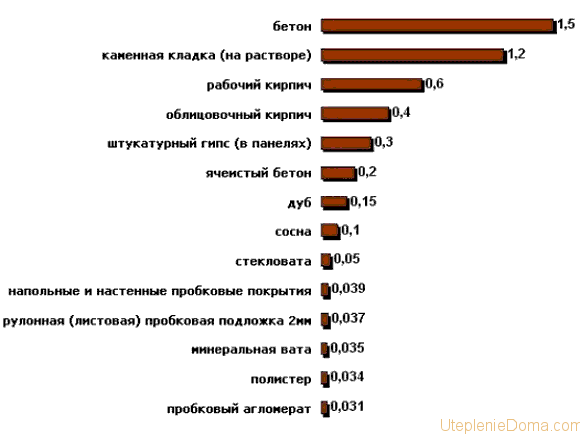
The table shows the thermal conductivity of the most common materials.
To calculate the heat resistance of walls and ceilings, one must divide their thickness by the coefficient of thermal conductivity of the materials from which they are made. The calculation is made for each material separately. Then all values are added together.
When we learned the heat resistance of the house, we can proceed to calculate the total heat loss. To do this, we multiply the quadrature of the house by the delta of the temperatures in the room and outside the window, and divide the result by the heat resistance. The delta of temperatures should be taken for the coldest period. Calculating the power of the electric boiler for heating the house, taking into account, first of all, heat losses will be the most accurate. So do not be lazy and use this way. Yes, it is more troublesome, but you need to take a lot of things into account, but the result will be adequate, you will correctly make the calculation.
Dependence of the power of electric boilers on the heat carrier

This is how the heat accumulator for the heating system looks.
Another factor that affects what should be electrical heating boilers (their power) is a coolant. What exactly can affect the result:
- volume of coolant;
- what applies in this case;
The latter factor is entirely indirect, but, nevertheless, it also changes the picture a whole a few percent, but the volume of the coolant is a very significant indicator. Let's say you did the right way (see which one was correct above) did the calculation of the boiler's power, but did not take into account that the heat accumulator is installed in your circuit. This tank holds a lot of liquid. In each case, its volume is considered separately, but on average not less than 300 liters.
To heat one liter of water by one degree per hour, it will take 0.001 kilowatts of energy.
The boiler heats the water to the level you set, take 40 degrees. At the first start the temperature of the coolant will be minimal, about 20 degrees. When it heats the coolant to the extent that the return reaches the exposed forty degrees, the unit will shut down. Or, the external thermal sensor will turn off the heater when the room temperature is reached, everything depends on the model and the "brains" of the device.
For example, in your system, in addition to the heat accumulator, another 100 liters of coolant circulates, in the amount of 400 liters. In order to heat up such a volume of water, the boiler will need 9.6 kW of energy, taking into account that the efficiency of the heater will be 97%. The heating time depends on the power, if not enough, the boiler will not turn off at all. In addition, when calculating the power of electric heating boilers, one must take into account the characteristics of the coolant. So, for example, in antifreeze, the thermal conductivity is 15% lower than that of water.
Outcomes
Calculation of the boiler output must be carried out taking into account heat losses. The axial method, to take an eye 100 watts per square meter, does not stand up to any criticism. In addition, after the calculation, but before buying, you need to check whether the selected unit can cope with the volume of coolant in the system and how long it will take for this. Of course, I would like to somehow simpler make all the calculations, but alas, in this case, you need accuracy and focus on certain conditions.
The boiler is the main element for any independent heating system. This element still serves as a generator for thermal energy, its performance is very good. From a number of factors depends on what will be the cost of installing the device and its purchase in general. Including the calculation should take into account the mode of residence and location of the structure, features of construction and dimensions. And this list is far from complete. What kind of actions we will need, it is easy to understand. From the calculation, too, often depends on the choice of the devices themselves.
Fig. 1 Modern model of the applianceThe type of fuel and the efficiency of the installation are selected exactly according to the calculation results, the boiler only in this case will fully fulfill its function. The electrical appliance will be the most convenient and relevant solution in homes with an area of up to 300 m2. Thanks to this, a reliable heating system is created, which does not cause much trouble in the future. The electric heating boiler gives an efficiency of up to 98 percent, the performance always keeps a fairly high level, the calculation is easy.
Extensive optimization possibilities also make the electric boiler a very convenient acquisition, in addition to its other advantages. Installation is possible in any place, there is enough electricity. The electric boiler can become an additional source of heat for a system that already exists, or used separately. The calculation must take this into account.
Compared to devices operating from other sources, an electric heating boiler can be cheaper at the purchase stage. It is not necessary to contain a chimney for evacuation of gases, the device is safe from the point of view of ecology. Power for general security also does not affect how much it can go - no less important issue.
Electricity consumption. How to define it?
We will need some calculations in order to achieve the desired result.
In addition, the calculation requires the consideration of a number of parameters:
- Average daily duration of work at maximum load;
- Accommodation;
- Efficiency and productivity;
- Calculation of the working time in the heating season;
- Volume of coolant in the heating circuit;
- The size of the tank at the appliance;
- Calculation of the heating area;
- The voltage of the device for heating;
- Calculate the cross-section of the power cable;
- Calculation of the volume of heated rooms;
- Number of circuits in the equipment.
The calculation assumes the use of averaged values. It is necessary to introduce several corrections to such factors as the type of insulation used, the thermal conductivity of the walls, the temperature indexes, and so on. Power is also a must consider.
An electric heating boiler requires the use of a special cable. The main factor in his choice is power. There is a simple empirical dependence, which can be understood without difficulty: no less than the heating capacity expressed in kW, there should be a cross-sectional area of the cable in mm2 for a single-phase electric boiler. Due to this, calculation becomes simpler. It is necessary to coordinate their actions with the institutions that control the use of resources, if the indicator for the boiler is at the level of 10 kW or more.
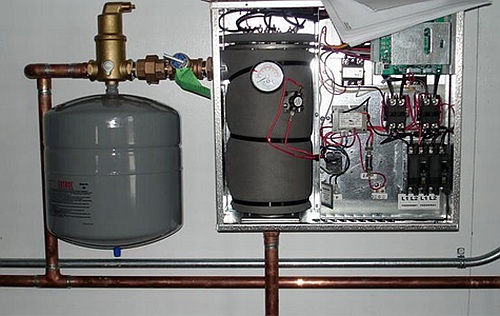 Fig. 2 Device from the inside
Fig. 2 Device from the inside Examples of calculations. The simplest ways
Efficiency, close to 100 percent, boasts only an electric heating boiler. Throughout the life of the device this indicator will remain stable, the figures confirm this. The level may vary, but the difference will remain small, it all depends on the specific conditions.
About 30-35 kW is a waste of electricity for heating one cubic meter. The thermal insulation of the structure can affect this parameter, but not to a large extent. The boiler's heating capacity should be 15 kW if the house is heated at 150 sq. M. 2 and with a three-meter high room. According to this formula, it is easy to calculate the power of an electric heating boiler. When the device is only purchased, it is best to calculate in advance so that there is a small margin. Calculation is easy.
If the power is produced in insufficient quantities, the temperature in the room will decrease. This disadvantage is much more difficult to compensate for than simply to put the device on a weak mode of operation. And the calculation of the boiler does not help. We will either have to install additional equipment for heating, or to insulate the building itself.
There are a number of important rules:
- The power of an electric heating boiler must be known in order to calculate the need for electricity for a year.
- The use of the resource for the boiler can be found for the whole season, if the total price for its use is known.
- The calculation will be as follows. The value, which is obtained as a result, is divided into two. The electric boiler simply can not always work with the maximum load. The operation of the boiler is not so necessary during the thaw period.
- To get the same figure, but for a month, the total figure is simply multiplied by 30. This process is not something very complicated.
It is generally believed that the heating boiler we need for seven months. Depending on the climatic conditions, you can make your own adjustments to this information. Monthly electricity consumption should be multiplied by the duration of the heating period to get the result for the whole year. But do not consider it as accurate as possible, the difference in reality can be up to 15-20 percent, even the most accurate approach will not save you from inaccuracies.
Often the calculation is based on the fact that each consumer needs about 3 kW. But in practice this capacity of boilers can not cope with the loads. This particularly applies to regions with a cold climate, where the energy consumption of the boiler can increase.
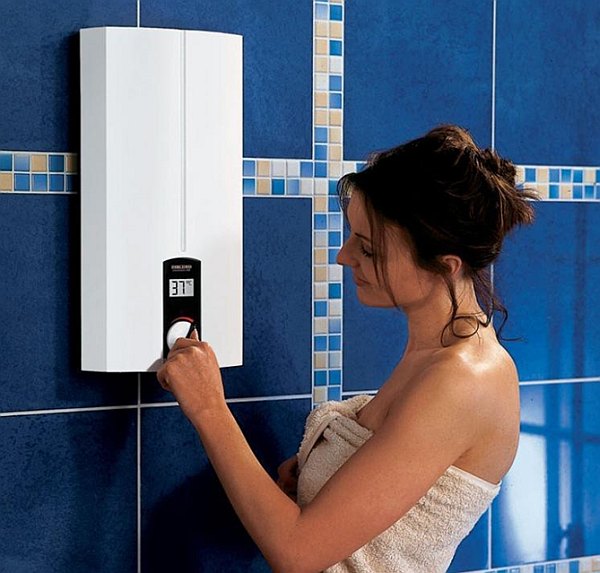 Fig. 3 Convenient adjustment of parameters
Fig. 3 Convenient adjustment of parameters Can I consume less electricity?
Calculation helps to understand the extent to which electric heating can be beneficial.
The following tips are simple, but they are sufficient to ensure that the electricity is consumed in smaller quantities:
- The easiest way to begin with the insulation of the house itself. If the old windows are inside, and they do not close tightly, the losses can be very serious. Heating costs will noticeably decrease if you put modern plastic windows, add air cameras in the amount of a couple of units. It will help in this and the electric boiler itself consumes electricity immediately.
- We need to warm the foundation and the roof. Power from this almost does not depend, but the result will definitely be different. The main thing is to see in advance in what quantities the material is needed, what properties it should possess. Expenditure on this depends not least.
- It is better to pay for the operation using multi-tariff accounting. Thanks to this, it is easy to calculate when the electric boiler will be most profitable to use.
- To accelerate the transfer of the coolant, it is possible to install a pressure equipment. The characteristics in this mode will allow the heat source to be operated for a longer time, since the walls of the boiler and the hot coolant are in contact for a minimum time.
- One of the most affordable solutions is to install other kinds of heating devices that use fuel for their work.
- And also ventilation with recuperator is used. If some heat is lost during the ventilation of rooms, then with the help of this device it will return. If the power is sufficient, then it will not be necessary to practically open the windows for ventilation.
Electricity will be spent in less quantity. And the moisture and air purity indicators will remain at a normal level. Power continues to please for a long time.
You can use the simplest formula.
- W = S x Wud. 10m2.
In this formula: W-power of the device in kW, S-the area of premises in square meters, Wud - specific power factor, for each region it is determined separately.
For example, in the middle band this value is 1, or 1.2. As a result of calculation with such figures, we get 16 kW. If the model is dual-circuit, you will need knowledge of the DHW circuit.
Each manufacturer is now trying to provide the buyer with a full set of equipment, which only he can need, the power is taken into account too. The electric boiler was no exception. In the kit with it go the programmer, the pump for circulation of the coolant, expansion tank. Thanks to this, it is easy to understand what the power rating of an electric boiler should be. Even a novice user can cope with this.
In addition, devices are required to protect equipment and special cables. Thus, the installation can be completely done by hand. The power of the boiler does not matter.
But sometimes it is required and self-sufficient doukomplektatsiya. For those who understand electrical models, this solution is often the most urgent. Including by power. The power supply system can be of the usual type if an electric boiler is installed, the power of which reaches 6 kW.
Since recently, electric power consumption by an electric boiler has become no less important than the installation of a special pump in the system. Such a decision also helps to understand how much electricity is wasted and why. In this case, the consumption is significantly reduced. In the system it will be possible to use pipes with a smaller diameter than in the usual situation. A pump with a wet rotor is the main type of equipment, which is most often seen in private houses. Its power is fully in line with the requirements.
- The rotor is washed with a liquid that is never pumped by electrical equipment. Consumption of resources becomes more profitable.
- There is no need to install an additional fan, since the device never overheats. The capacity of the boiler is sufficient for loads in the normal mode.
- Due to the fact that there is no fan, the operation of the whole system becomes almost silent. In residential buildings, this becomes particularly relevant, the power does not suffer from this.
Such pumps themselves can support automatic or manual adjustment. Power in this case does not play a big role. The first option is most preferable, because it allows you to save electricity. Then the heating with an electric boiler becomes more profitable.
How much does his work cost? To make a calculation, it is enough to know about some features of operation. For example, what temperature is most often maintained indoors. Concerning general scheme for heating the house, it is best to choose forced circulation. It is too the best option, allowing you to achieve maximum results with minimal investment.
In a rather harsh environment in most regions of our country to have a well-functioning heating system is an important task. And the heart of the whole system has always been a source of heat or a boiler. Today you can buy heat-transfer device different designs. They will differ both in their functionality and in the fuel used. Which one to choose is the decision of the owner of the house. But here it is important to choose a suitable device for power. This is exactly what will be discussed in this article. Here it will be told which electric boilers for heating houses with an area of one hundred square meters are better to choose.
Advantages and disadvantages of heating boilers
Many owners of private houses very often choose electric boilers for heating. This is facilitated by a number of advantages that these devices give. Namely:

It is these advantages, such as ease of installation and operation, low price, automation and high efficiency, make electric boilers quite popular for heating a private house. In addition, there is no need to worry about buying fuel. But even such high-tech equipment has its drawbacks.
The minuses of electric boilers include:
- if electricity is supplied regularly, then the house will be warm. But the cost of this fuel is constantly growing. Therefore, heating costs are also increasing. Today in the winter months for a house of 100 square meters of space, the electricity bill can reach double digits;
- one more minus is connected with electro supplying organizations. In many settlements there is a limit on the amount of electricity supplied for one private household. Very often, these capacities may simply not be enough to maintain the desired temperature in the house;
- also, the minuses include the high wear and tear of the power grids, especially in rural areas.
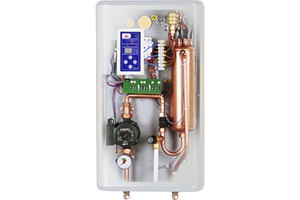 But, if you are all right with the supply of electricity, then use electric boilers for heating - this the best option. And the cost of electricity will be large only in the cold months, besides you can regulate your own consumption simply reducing or increasing the boiler output.
But, if you are all right with the supply of electricity, then use electric boilers for heating - this the best option. And the cost of electricity will be large only in the cold months, besides you can regulate your own consumption simply reducing or increasing the boiler output.
Types of electric heating boilers
Before talking about power electric boiler for home heating in 100 square meters, it is worth learning about their varieties. Today on sale you can find a variety of models, which can vary in different parameters. Namely:
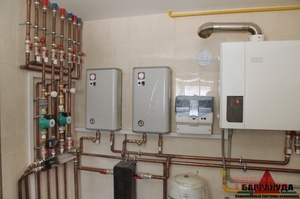
What equipment to choose is the business of the owner of a private house. The main thing is that the power of the electric boiler is sufficient to maintain normal temperature.
Calculation of the power of an electric boiler for heating a house of 100 square meters
Make the right boiler capacity calculations heating is an important task. From the correctness of its decision will depend on a comfortable stay in the house in the winter.
At calculations it is necessary to study some parameters of the house. Namely:
- the volume of all heated rooms. This is the most important indicator. According to requirements health standards for one cubic meter of room should be 40 watts of power of heaters. Calculate cubature is simple enough. For this, the area of all rooms is multiplied by the height of the ceiling. In our case, taking the standard distance from floor to ceiling of 2.7 meters, we get 100 sq.m. * 2.7 m = 270 cubic meters;
- it is necessary to know the number of windows and doors in the house. Through these elements, heat can escape from the room. For each window, add 100 watts of power to the heaters, and all 200 watts on the door. Take (conditionally) that the house has an area of 100 square meters of 6 windows and as many internal doors. Means, to power it is necessary to add 1800 W;
- you also need to consider the ratio of your region. It's no secret that in our large country the winter is not always equally cold. therefore for the southern regions, a special coefficient 0.7-0.9, for the central strip it will be 1.2-1.4, and in the northern regions, where the winter is the most frosty, the coefficient is 1.7-1.9. For a house in the central strip of Russia, take the average value of 1.3;
- since the house is an individual structure, it is surrounded on all sides by unheated plots. To compensate for the cold coming from the floor, attic and external walls, it is necessary to apply one more factor equal to 1.5;
- also it is necessary to add 20 percent in case of abnormally strong frosts and still the same if you have a double-circuit boiler (for heating water for a water pipe).
![]() Considering all the above, it is possible to calculate the required power of an electric boiler for heating a house with an area of 100 square meters.
Considering all the above, it is possible to calculate the required power of an electric boiler for heating a house with an area of 100 square meters.

